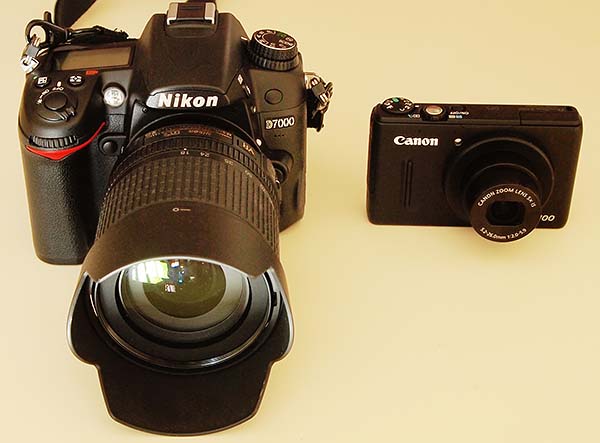Canon S100 User Report
Page 1 of 3. Version 1.1, ©2011 by Dale Cotton, all rights reserved.
Written from the point of view of an average-sized veteran still image, available light photographer who mainly shoots raw, never shoots video, and does about an equal mix of street, candids, landscapes, and weird blurry stuff.
Note. Written after two weeks of extensive testing and quite a bit of use. Check back for updates.

Fig. 1: S100 front
Intro
The best camera is the one you have with you. The trick is to have the best possible camera with you at all times. One solution is to ignore its extreme limitations and make do with one's smart phone. Another is to buy a small camera – anything from a point & shoot compact to an APS-C mirrorless with kit lens – as one's main tool, then keep it with you wherever you go. Yet another is to own a highly capable system camera such as a dSLR, but also own a pocket camera to have with you at all times.
I've tried all of the above at one point or another but have long been stymied re the third option by the lack of a quality pocket camera. A true shirt pocket camera with raw output, tolerable IQ even in low light, usable zoom range, adequate focus and exposure control, image stabilization, plus an acceptable shutter lag (let alone shot-to-shot time) has been a long time coming. Although these things looked to be true of the S100's predecessor, I skipped the S95 due to some nagging sense of wanting to see what the next iteration would deliver. I also considered the Olympus XZ-1, but its larger size, more protruding lens, and apparent lack of sufficient control points caused me to move on. Having owned the LX1, I was not about to opt for the LX5 with its protruding lens requiring a lens cap; and in any case have seen no sign that Panasonic has achieved parity in noise handling.
Physical design

Fig. 2: S100 top
First impressions. The size of a deck of cards with only a centimeter of lens protrusion, a 3 inch LCD, plus a generous sprinkling of buttons and dials – that covers the essentials of the S100's physical presence... objectively speaking. What it doesn't tell you is that when you first pick up an S100 two things compete for your attention: its tiny-perfect size and the cues it exudes of sheer physical quality, clearly intended for maximum tactile seduction. This latter especially includes its heft, which gives the sense of being a solid block of metal.
Beyond seductiveness, the design mandate was clearly to see how much camera could be squeezed into the shirt pocket form factor established by the Elph/Ixus line. A niggling but common complaint re its predecessors, the S90 and S95, was the lack of a secure grip. The S100 rectifies that by providing a minimal finger ridge on the front face plus a small protruding thumb rest on the back. More importantly, the metal casing is coated with an almost sandpaper-textured matte surface that is a joy to handle. Together, these remedies retain the all-important Elph/Ixus gestalt while solving the grip problem. Anyone who has worked with a camera such as the Panasonic LX series will also feel an inexpressible joy at being freed from the perpetual lenscap hassle.
Screen. Lacking even an attachable viewfinder, everything depends on the LCD. The S100's gloss-finished 3 inch, 460K dot. 3:4 aspect ratio panel is a pleasure to use indoors but suffers from sunlight reflections just as much as its predecessors, even at the max brightness setting. It's also as much a fingerprint magnet as your smartphone screen. As noted by other reviewers the 460K resolution is not really adequate for eyeballing manual focus, but for me at least, the on-screen distance scale goes a long way toward overcoming that. The miniscule sensor inside has such a huge depth of field that focus beyond the first yard/meter or two is rarely an issue, and one can use the distance scale together with a guesstimate for closer distances. I'm also seeing an exceptionally colour-neutral image on-screen in all lightings. The one exception is the blue channel clipping that occasionally results in a cyan instead of blue sky.
Update, 06 Feb: I put an Optex LCD Screen Protector (transparent stick-on film) on the LCD of my S100 to protect against scratches. Not only does it make fingerprints virtually unnoticeable, it is also a game-changer when using the camera in bright sunlight. Turn screen brightness to max and the image on the LCD is quite usable. The Optex film is slightly textured to eliminate maybe 90% of the mirror-like reflections which render the uncovered glass of the LCD unreadable.
Controls. The buttons and dials are the same size as those on my dSLR. The on/off, ring function, and display buttons are (purposely) so recessed as to be hard to find by feel alone. But the mode dial is tight enough and positive enough not to accidentally move when in case or pocket. The lens ring and control ring have just the right action and click-stop positiveness.